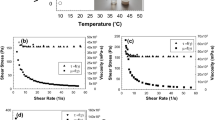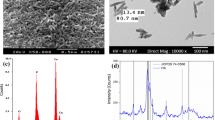Abstract
Thermosensitive injectable hydrogels are widely investigated as a minimally invasive tool for the delivery of therapeutic agents. Here, Pluronic F-127 hydrogels containing mesoporous bioactive glass nanoparticles were obtained as a novel device to improve bone tissue regeneration. Thermosensitive behavior and injectability of the obtained nanocomposites hydrogels were evaluated, showing feasibility for minimally invasive administration and sol–gel phase transition in the range of 18 to 23 °C, suitable for use as an injectable system. Rheological evaluation showed that adding bioactive glass improved the hydrogel elastic properties and stability at body temperature, also increasing the storage modulus (G’) and residence time. The injectability evaluation showed that all formulations were able to be administrated using a maximum force of up to 2.4 ± 0.4 N, compatible with manual injection. The results shows that Pluronic F-127/mesoporous bioactive glass systems are potential candidates to be applied as injectable systems for therapeutic agents release in situ.










Similar content being viewed by others
References
Moreira CDF et al (2019) Injectable chitosan/gelatin/bioactive glass nanocomposite hydrogels for potential bone regeneration: in vitro and in vivo analyses. Int J Biol Macromol 132:811–821
Amirthalingam S et al (2021) Combinatorial effect of nano whitlockite/nano bioglass with FGF-18 in an injectable hydrogel for craniofacial bone regeneration. Biomater Sci 9:2439–2453
Liao J et al (2017) Injectable alginate hydrogel cross-linked by calcium gluconate- loaded porous microspheres for cartilage tissue engineering. ACS Omega. https://doi.org/10.1021/acsomega.6b00495
Cai Z et al (2021) Anti-Inflammatory and prochondrogenic in situ-formed injectable hydrogel crosslinked by strontium-doped bioglass for cartilage regeneration. ACS Appl Mater Interfaces 13:59772–59786
Vitale-Brovarone C et al (2018) Hybrid injectable platforms for the in situ delivery of therapeutic ions from mesoporous glasses. Chem Eng J 340:103–113
Sang X, Zhao X, Yan L, Jin X, Wang X (2022) Thermosensitive hydrogel loaded with primary chondrocyte- derived exosomes promotes cartilage repair by regulating macrophage polarization in osteoarthritis. Tissue Eng Regen Med 19:629–642
Chatterjee S, Hui PC, Kan C (2018) Thermoresponsive hydrogels and their biomedical applications: special insight into their applications in textile based transdermal therapy. Polymers. https://doi.org/10.3390/polym10050480
Moreira CDF et al (2018) Nanostructured chitosan/gelatin/bioactive glass in situ forming hydrogel composites as a potential injectable matrix for bone tissue engineering. Mater Chem Phys 218:304–316
Deliormanlı AM, Türk M (2020) Flow behavior and drug release study of injectable Pluronic F - 127 hydrogels containing bioactive glass and carbon - based nanopowders. J Inorg Organomet Polym Mater 30:1184–1196
Zambanini T et al (2021) Holmium-containing bioactive glasses dispersed in poloxamer 407 hydrogel as a theragenerative composite for bone cancer treatment. Materials (Basel). https://doi.org/10.3390/ma14061459
Gyles D, Diniz L, Otávio J, Silva C, Ribeiro-costa RM (2017) A review of the designs and prominent biomedical advances of natural and synthetic hydrogel formulations. Eur Polym J 88:373–392
Klouda L (2015) Thermoresponsive hydrogels in biomedical applications a seven-year update. Eur J Pharm Biopharm. https://doi.org/10.1016/j.ejpb.2015.05.017
Kjøniksen A, Calejo MT, Zhu K, Nystr B, Sande SA (2014) Stabilization of pluronic gels in the presence of different polysaccharides. J Appl Polym Sci 40465:1–8
Hom WL, Bhatia SR (2017) Significant enhancement of elasticity in alginate-clay nanocomposite hydrogels with PEO-PPO-PEO copolymers. Polymer (Guildf) 109:170–175
Yang J, Yeom J, Woo B, Hoffman AS, Kwang S (2014) In situ -forming injectable hydrogels for regenerative medicine. Prog Polym Sci 39:1973–1986
Jones JR (2013) Review of bioactive glass: from Hench to hybrids. Acta Biomater 9:4457–4486
Barabadi Z et al (2016) Fabrication of hydrogel based nanocomposite scaffold containing bioactive glass nanoparticles for myocardial tissue engineering. Mater Sci Eng C 69:1137–1146
Mosqueira L et al (2021) Strontium-releasing sol–gel bioactive glass spheres and their ability to stimulate osteogenic differentiation in osteoporotic bone marrow mesenchymal stem cells. J Mater Res 36:459–474
Nawaz Q et al (2018) Synthesis and characterization of manganese containing mesoporous bioactive glass nanoparticles for biomedical applications. J Mater Sci Mater Med. https://doi.org/10.1007/s10856-018-6070-4
Liu M et al (2017) Injectable hydrogels for cartilage and bone tissue engineering. Bone Res. https://doi.org/10.1038/boneres.2017.14
Jones JR (2009) New trends in bioactive scaffolds: the importance of nanostructure. J Eur Ceram Soc 29:1275–1281
Utech S, Boccaccini AR (2016) A review of hydrogel-based composites for biomedical applications: enhancement of hydrogel properties by addition of rigid inorganic fillers. J Mater Sci 51:271–310
Won D, Kim M, Tae G (2015) Colloids and surfaces B: biointerfaces systemic modulation of the stability of pluronic hydrogel by a small amount of graphene oxide. Coll Surf B Biointerfaces 128:515–521
Gioffredi E et al (2016) Pluronic F127 hydrogel characterization and biofabrication in cellularized constructs for tissue engineering applications. Procedia CIRP 49:125–132
Moreira CDF, Carvalho SM, Mansur HS, Pereira MM (2016) Thermogelling chitosan-collagen-bioactive glass nanoparticle hybrids as potential injectable systems for tissue engineering. Mater Sci Eng C 58:1207–1216
Chen S et al (2020) Biodegradable zinc-containing mesoporous silica nanoparticles for cancer therapy. Mater Today Adv. https://doi.org/10.1016/j.mtadv.2020.100066
Boonlai W, Tantishaiyakul V, Hirun N, Sangfai T, Suknuntha K (2018) Thermosensitive poloxamer 407/Poly(Acrylic Acid) hydrogels with potential application as injectable drug delivery system. AAPS PharmSciTech 19:2103–2117
Radivojša M, Grabnar I, Grabnar PA (2013) Thermoreversible in situ gelling poloxamer-based systems with chitosan nanocomplexes for prolonged subcutaneous delivery of heparin: design and in vitro evaluation. Eur J Pharm Sci 50:93–101
Boffito M et al (2016) Novel polyurethane-based thermosensitive hydrogels as drug release and tissue engineering platforms: design and in vitro characterization. Polym Int. https://doi.org/10.1002/pi.5080
Xin C, Lihong W, Qiuyuan L, Hongzhuo L (2014) Injectable long-term control-released in situ gels of hydrochloric thiothixene for the treatment of schizophrenia: preparation, in vitro and in vivo evaluation. Int J Pharm 469:23–30
Hoppe A, Güldal NS, Boccaccini AR (2011) A review of the biological response to ionic dissolution products from bioactive glasses and glass-ceramics. Biomaterials. https://doi.org/10.1016/j.biomaterials.2011.01.004
Zheng K, Boccaccini AR (2017) Sol-gel processing of bioactive glass nanoparticles: a review. Adv Coll Interface Sci 249:363–373
Thommes M et al (2015) Physisorption of gases, with special reference to the evaluation of surface area and pore size distribution (IUPAC Technical Report). Pure Appl Chem 87:1051–1069
Zheng Y et al (2016) In vitro study of calcium phosphate layers on hydroxyapatite ceramics surface mineralized in different solutions. Ceram Int 42:1660–1665
Li Y, Chen X, Ning C, Yuan B, Hu Q (2015) Facile synthesis of mesoporous bioactive glasses with controlled shapes. Mater Lett 161:605–608
Nawaz A, Bano S, Yasir M, Wadood A, Ur Rehman MA (2020) Ag and Mn-doped mesoporous bioactive glass nanoparticles incorporated into the chitosan/gelatin coatings deposited on PEEK/bioactive glass layers for favorable osteogenic differentiation and antibacterial activity. Mater Adv 1:1273–1284
Yap LS, Yang MC (2016) Evaluation of hydrogel composing of Pluronic F127 and carboxymethyl hexanoyl chitosan as injectable scaffold for tissue engineering applications. Coll Surf B Biointerfaces 146:204–211
Xie Y, Tang J, Lu Z, Sun Z, An L (2013) Effects of poly(Propylene Oxide)–Poly(Ethylene Oxide)–Poly(Propylene Oxide) triblock copolymer on the gelation of poly(Ethylene Oxide)–poly(Propylene Oxide)–poly(Ethylene Oxide) aqueous solutions. J Macromol Sci Part B 52:1183–1197
Bonacucina G, Cespi M, Mencarelli G, Giorgioni G, Palmieri GF (2011) Thermosensitive self-assembling block copolymers as drug delivery systems. Polymers. https://doi.org/10.3390/polym3020779
Matanović MR, Kristl J, Grabnar PA (2014) Thermoresponsive polymers: Insights into decisive hydrogel characteristics, mechanisms of gelation, and promising biomedical applications. Int J Pharm 472:262–275
Boucenna I, Royon L, Colinart P, Guedeau-Boudeville MA, Mourchid A (2010) Structure and thermorheology of concentrated pluronic copolymer micelles in the presence of laponite particles. Langmuir 26:14430–14436
Carlfors J, Edsman K, Petersson R, Jörnving K (1998) Rheological evaluation of Gelrite® in situ gels for ophthalmic use. Eur J Pharm Sci 6:113–119
Dou Q, Karim AA, Loh XJ (2016) Modification of thermal and mechanical properties of PEG-PPG-PEG copolymer (F127) with MA-POSS. Polymers (Basel). https://doi.org/10.3390/polym8090341
Zhang M, Djabourov M, Bourgaux C, Bouchemal K (2013) Nanostructured fluids from pluronic® mixtures. Int J Pharm 454:599–610
Gentile L, De Luca G, Antunes FE, Rossi CO, Ranieri GA (2010) Thermogelation analysis of F127-water mixtures by physical Chemistry techniques. Appl Rheol 20:1–12
Zhang L, Parsons DL, Navarre C, Kompella UB (2002) Development and in-vitro evaluation of sustained release Poloxamer 407 (P407) gel formulations of ceftiofur. J Control Rel 85:73–81
Won DA, Kim M, Tae G (2015) Systemic modulation of the stability of pluronic hydrogel by a small amount of graphene oxide. Coll Surf B Biointerfaces 128:515–521
Branca C, Khouzami K, Wanderlingh U, D’Angelo G (2018) Effect of intercalated chitosan/clay nanostructures on concentrated pluronic F127 solution: a FTIR-ATR, DSC and rheological study. J Coll Interface Sci 517:221–229
Sergi R, Bellucci D, Cannillo V (2020) A review of bioactive glass/natural polymer composites: state of the art. Materials (Basel) 13:1–38
Martins T et al (2017) Novel 3D composites with highly flexible behavior based on chitosan and bioactive glass for biomedical applications. Mater Chem Phys 189:1–11
Gantar A et al (2014) Nanoparticulate bioactive-glass-reinforced gellan-gum hydrogels for bone-tissue engineering. Mater Sci Eng C 43:27–36
Leite AJ, Mano JF (2017) Biomedical applications of natural-based polymers combined with bioactive glass nanoparticles. J Mater Chem B 5:4555–4568
Quah SP, Smith AJ, Preston AN, Laughlin ST, Bhatia SR (2018) Large-area alginate/PEO-PPO-PEO hydrogels with thermoreversible rheology at physiological temperatures. Polymer (Guildf) 135:171–177
Dumortier G, Grossiord JL, Agnely F, Chaumeil JC (2006) A review of poloxamer 407 pharmaceutical and pharmacological characteristics. Pharm Res 23:2709–2728
Su YL, Wang J, Liu HZ (2002) FTIR spectroscopic investigation of effects of temperature and concentration on PEO-PPO-PEO block copolymer properties in aqueous solutions. Macromolecules 35:6426–6431
de Laia AGS et al (2020) Therapeutic cobalt ion incorporated in poly(vinyl alcohol)/bioactive glass scaffolds for tissue engineering. J Mater Sci 55:8710–8727
Park KM et al (2009) Thermosensitive chitosan-Pluronic hydrogel as an injectable cell delivery carrier for cartilage regeneration. Acta Biomater 5:1956–1965
Fu S et al (2009) Injectable biodegradable thermosensitive hydrogel composite for orthopedic tissue engineering. 1. Preparation and characterization of nanohydroxyapatite/ poly(ethylene glycol)-poly(ε-caprolactone)-poly(ethylene glycol) hydrogel nanocomposites. J Phys Chem B 113:16518–16525
dos Santos DMM, de Carvalho SM, Pereira MM, Houmard M, Nunes EHM (2019) Freeze-cast composite scaffolds prepared from sol-gel derived 58S bioactive glass and polycaprolactone. Ceram Int 45:9891–9900
Jung YP et al (2017) Thermo-sensitive injectable hydrogel based on the physical mixing of hyaluronic acid and Pluronic F-127 for sustained NSAID delivery. Carbohydr Polym 156:403–408
Diniz IMA et al (2015) Pluronic F-127 hydrogel as a promising scaffold for encapsulation of dental-derived mesenchymal stem cells. J Mater Sci Mater Med 26:1–10
Cilurzo F et al (2011) Injectability evaluation: an open issue. AAPS Pharm Sci Tech 12:604–609
Rungseevijitprapa W, Bodmeier R (2009) Injectability of biodegradable in situ forming microparticle systems (ISM). Eur J Pharm Sci 36:524–531
Acknowledgements
The authors also gratefully acknowledge financial support from CNPq, CAPES and FAPEMIG/Brazil.
Author information
Authors and Affiliations
Corresponding author
Ethics declarations
Conflict of interest
The authors declare that there is no conflict of interest concerning the publication of this paper.
Additional information
Handling Editor: Christopher Blanford.
Publisher's Note
Springer Nature remains neutral with regard to jurisdictional claims in published maps and institutional affiliations.
Rights and permissions
About this article
Cite this article
Queiroz, P.M., Barrioni, B.R., Nuncira, J. et al. Injectability study and rheological evaluation of Pluronic-derived thermosensitive hydrogels containing mesoporous bioactive glass nanoparticles for bone regeneration. J Mater Sci 57, 13027–13042 (2022). https://doi.org/10.1007/s10853-022-07468-2
Received:
Accepted:
Published:
Issue Date:
DOI: https://doi.org/10.1007/s10853-022-07468-2




